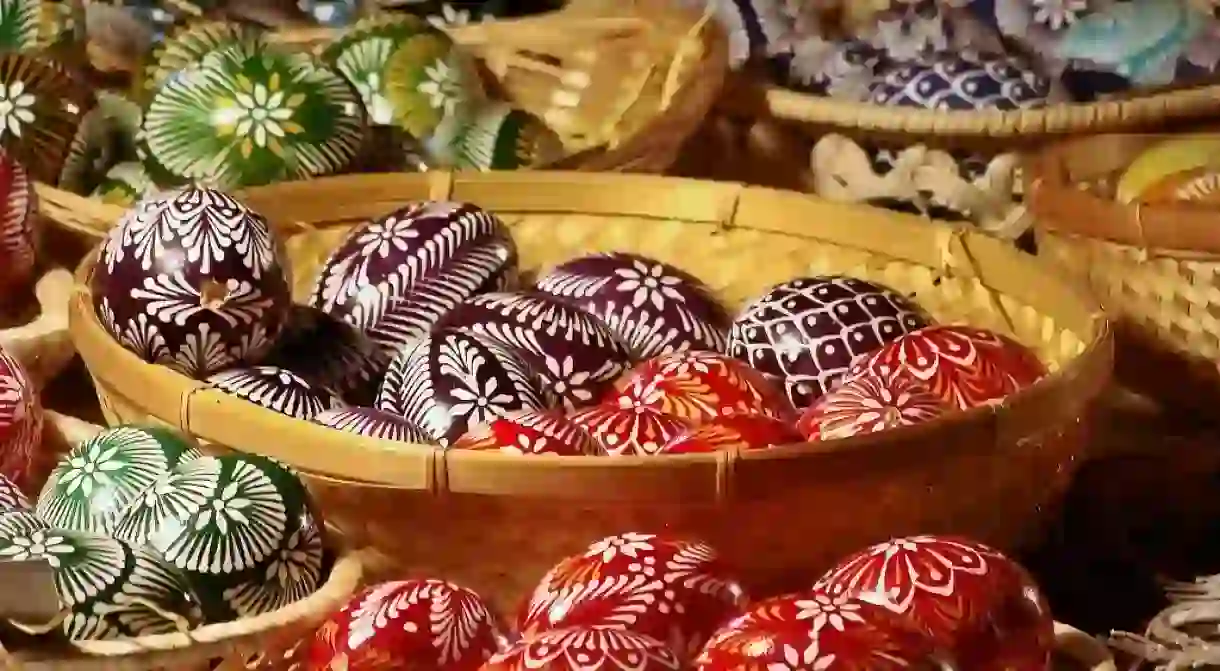How and Where to Celebrate Easter in Hungary

Easter in Hungary is celebrated in a number of unique and colorful ways. Steeped in tradition, the holiday is honored with a number of festivals, events and customs, a number of which are totally different from those held anywhere else.
Painted Eggs
Painting eggs is common in Hungarian folk art, and at Easter they’re in full abundance. The art of decorating eggs goes back centuries. Originally, the eggs were painted red to symbolise the blood of Jesus. Today, a range of brightly colored eggs can be found around Easter time, hand painted and gracing market stalls, shop windows and homes up and down the country. Decoration is added in the form of simple shapes, or more intricate ancient symbols, plants and flowers (which take their inspiration from the decorations on Hungarian national costume).
A number of methods can be used to add pattern to the eggs. One popular option is to draw the desired design on the plain egg using wax. The egg is then dipped in a dye of choice to color it, before the wax is warmed and melted off, leaving the decoration plain to see.

Food and drink
Around Easter, a number of traditional Hungarian dishes are served up. While Good Friday usually sees fish dishes on the table (as they often are in other countries according to Christian tradition), Easter Sunday is a day for eating meat. Lamb, or ham with horseradish, are often the dishes of choice. Boiled eggs and a braided bread loaf called kalács are oftenserved up for Easter breakfast. One way in which Easter in Hungary doesn’t differ from elsewhere is in the addition of chocolate eggs. A relatively modern addition to the celebrations, they’re eaten in abundance just as they are across the world!

Locsolkodás
This unique, centuries old tradition, takes place on Easter Monday, and sees boys and men visit female friends and family, reading a poem to them before sprinkling them with perfume. Back in the day, the tradition was a little more bracing: instead of perfume, buckets of water were usually poured over women (and some still use this technique today!). Originally, young women of marriage age were the targets, as the water was said to represent fertility (as in old pagan rituals). Today, there are no restrictions and female friends and family of all ages are at risk of being doused.
The tradition kicks off early in the morning, and continues throughout the day. In return for sprinkling women with perfume, the men are rewarded with small gifts including painted or chocolate eggs, cakes and alcohol, usually the very strong Hungarian fruit brandy pálinka. Bearing in mind that the tradition goes on for an entire day, groups of pretty drunk men can often be seen stumbling through the streets come evening!

Easter Events in Hungary
Budapest Spring Fair, Vörösmarty tér
A great way to celebrate both the arrival of Spring and Easter is by heading to this fair held on one of downtown Budapest’s most picturesque squares, Vörösmarty tér. Hungarian folk art, pieces by local designers and traditional food and drink can all be enjoyed at this Spring festival.
Dates: March 31 – April 30, 2017 (subject to change)

Easter Lamb Festival, Budapest
A food focused event, visitors to this festival held in the magical surroundings of Vajdahunyad Castle in City Park, can taste a variety of lamb dishes. Judging takes place on the Sunday, and the best lamb dish is awarded the “Golden Lamb Award”. There are also Easter themed activities and folklore performances.
Dates: April 15 – 17
Easter Festival, Hollókő
The Hungarian village of Hollókő, which enjoys World Heritage status, is the site for one of the country’s most well known and traditional Easter celebrations. Food, drink, live music performances and plenty more await visitors, with a number of events occurring in the medieval Hollókő Castle.
Dates: Easter Weekend

Easter Festival, Szentendre
Travel back in time to the Hungary of years gone by and experience Easter as it was celebrated centuries ago in the pretty town of Szentendre. Skanzen, an open air museum which is a recreation of an original Hungarian village, holds an annual Easter festival at which visitors can learn to paint eggs, take part in traditional Easter activities, and even enjoy Locsolkodás as it used to be done (with buckets of cold water!).
Dates: April 16 – 17













